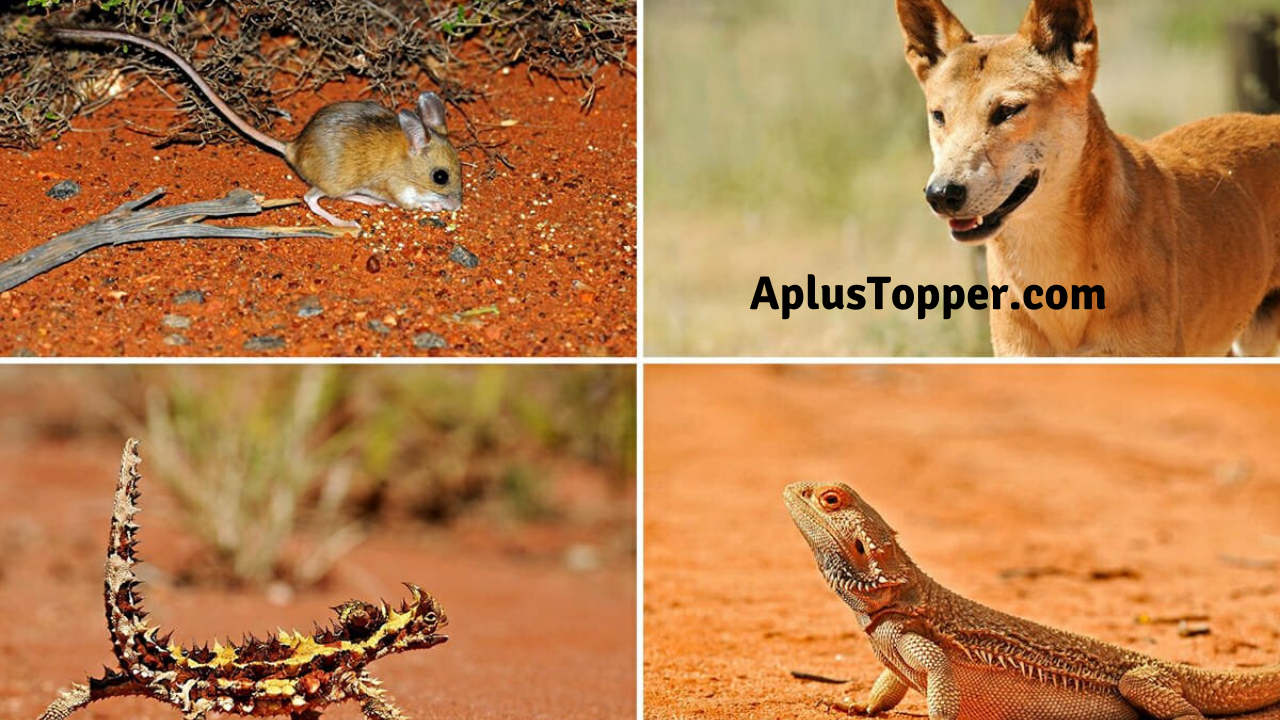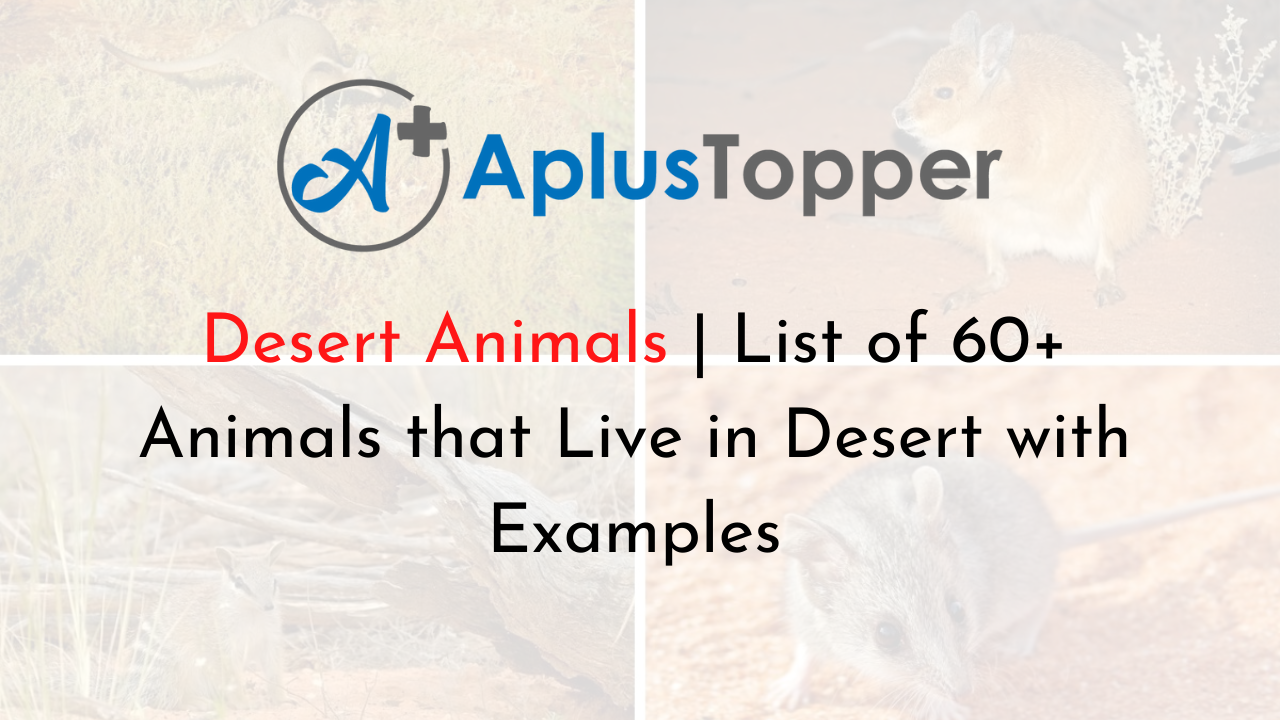Desert Animals: A desert is a particular area on the Earth that undergoes less than ten inches of rain every year. In every place on the Earth, life forms live as per their suitable habitat. Just like the desert consisting of vegetation, animals are no exception in arid regions. This article lists more than 60 animals residing in desert regions.
Desert Animals
- List of Birds found in the Desert Region
- List of Reptiles found in the Desert Region
- List of Insects found in the Desert Region
- List of Amphibians found in the Desert Region
- List of Animals found in the Desert Region
- Example Sentences for all animals mentioned above
List of Birds Found in the Desert Region
- Ferruginous Pygmy-Owl: Scientific name Glaucidium brasilianum.
- Cactus Wren: Scientific name Campylorhynchus brunneicapillus.
- Rosy-faced Lovebird: Scientific name Agapornis roseicollis.
- Lucifer Hummingbird: Scientific name Calothorax lucifer.
- Pin-tailed Sandgrouse: Scientific name Pterocles alchata.
- Greater Roadrunner: Scientific name Geococcyx californianus.
- Burrowing Owl: Scientific name Athene cunicularia.
- Verdin: Scientific name Auriparus flaviceps.
- Gila Woodpecker: Scientific name Melanerpes uropygialis.
- Gambel’s Quail: Scientific name Callipepla gambelii.
List of Reptiles found in the Desert Region
- Inland Bearded Dragon: Scientific name Pogona vitticeps.
- Collared Lizards: Scientific name Crotaphytus bicinctores.
- Greater Earless Lizard: Scientific name Cophosaurus texanus.
- Desert Iguana: Scientific of Dispsosaurus dorsalis.
- Side-blotched Lizard: Scientific name Uta stansburiana.
- Sidewinder: Scientific name Crotalus cerastes.
- Western Diamondback Rattlesnake: Scientific name Crotalus atrox.
- Ball Python: Scientific name Python regius.
- Southern Pacific Rattlesnake: Scientific name Crotalus oreganus helleri.
- Desert Horned Viper: Scientific name Cerastes cerastes.
- Striped Whipsnake: Scientific name Masticophis taeniatus.
- Coachwhip Snake: Scientific name Masticophis flagellum.
- Western Ornate Box Turtle: Scientific name Terrapene ornata.
- American Copperhead: Scientific name Agkistrodon contortrix.
- Desert Tortoise: Scientific name Gopherus agassizii.
List of Insects Found in the Desert Region
- Fire Ant: Scientific name Solenopsis Xyloni.
- Velvet Ants: Scientific name Mutillidae Family.
- Western Tiger Swallowtail: Scientific NamePapilio Rutulus.
- Honey bee: Scientific name Apis Mellifera.
- Harvester Ants: Scientific name Pogonomyrmex spp.
- Blister Beetle: Scientific name Hycleun Lugens of the Meloidae phylum.
- Viceroy Butterfly: Scientific name Limenitis Archippus.
- Pinacate Beetles: Scientific name Eleodes Obscurus.
- Black or Yellow Garden Spider: Scientific nameArgiope Aurantia.
- Wolf Spiders: Scientific name Lycosidae Araneae.
- Assassin Bug: Scientific name Hemiptera Reduviidae.
- Praying Mantis: Scientific name Mantis religiosa.
- Tarantula Hawk: Scientific name Hemipepsis Ustulata.
- Wasp: Scientific name Vespula Germanica.
- Termites: Scientific name Coptotermes Formosanus.
- Walking Stick: Scientific name Medauroidea Extradentata.
- Tick: Scientific name suborder Ixodida.
- Cicadas: Scientific name Genera Magicicada.
List of Amphibians found in the Desert Region
- Red-spotted toad: Scientific nameAnaxyrus Punctatus.
- Tiger salamander: Scientific name Ambystoma Tigrinum.
- California chorus frog: Scientific name Pseudacris Cadaverina.
- Couch’s spadefoot: Scientific nameScaphiopus Couchi.
- Lowland Leopard Frog: Scientific name Rana yavapaiensis or Lithobates yavapaiensis.
- Desert rain frog: Scientific name Breviceps macrops.
- Cliff Chirping Frog: Scientific nameEleutherodactylus marnockii.
- African bullfrog: Scientific name Pyxicephalus adspersus.
- Great Plains toad: Scientific name Anaxyrus cognatus.
- Woodhouse’s toad: Scientific name Anaxyrus woodhousii.
List of Animals found in the Desert Region
- The African Wild Dog: Scientific name Lycaon pictus.
- The Badger: Scientific name Taxidea taxus.
- Nine-Banded Armadillo: Scientific name Dasypus novemcinctus.
- Black Bears: Scientific name Ursus americanus.
- The Plains Bison: Scientific name Bison bison.
- Bobcats: Scientific name Felis Rufus.
- Bighorn Sheep: Scientific name Ovis canadensis.
- Cheetah: Scientific name Acinonyx jubatus.
- Llama:Scientific name Llama Glama.
- Dama Gazelle:Scientific name Gazella dama.
- The Raccoon: Scientific name Procyon lotor.
- White Rhinoceros: Scientific name Ceratotherium simum.
- Black Rhinoceros: Scientific name Diceros bicornis.
- Wild Bactrian Camel: Scientific name Camelus ferus.
- Cairo Spiny Mouse: Scientific name Acomys cahirinus.

Example Sentences for all animals mentioned above
- The Ferruginous Pygmy-Owl is brownish to greyish in color.
- Cactus Wren is the formal state bird of Arizona in the United States.
- Rosy-faced Lovebirds are known to chirp very loudly.
- Lucifer Hummingbirds live in high-altitude regions of the desert.
- Pin-tailed Sandgrouse looks very similar to pigeons we see every day.
- The Californian Earth Cuckoos are also called Greater Roadrunners.
- Last night my uncle rescued a Burrowing Owl.
- Our teacher taught us about what a Verdin eats in the desert.
- Gila Woodpeckers can be easily identified due to the intricate black and white features on their wings.
- Gambel’s Quail can be seen near water channels very often.
- Our neighbor owns an Inland Bearded Dragon, and his name is Stitch.
- Our science book has pictures of Collared Lizards.
- Greater Earless Lizards are known not to possess an ear opening.
- If you travel to the Sonoran Desert, you can spot a Desert Iguana.
- Side-blotched Lizards are commonly known reptiles in North American deserts.
- Sidewinders are a venomous species of rattlesnakes.
- Western Diamondback Rattlesnakes are a very rare species.
- Ball Pythons are the smallest rattlesnakes.
- If you ever visit the grasslands, beware of Southern Pacific Rattlesnakes.
- Desert Horned Vipers come out to hunt mostly at night, being nocturnal reptiles.
- Striped Whipsnakes are nonvenomous snakes.
- The other day, my brother told us a story about Coachwhip Snakes.
- Sarah owns a Western Ornate Box Turtle as her pet.
- Snake catchers advise residents never to disturb American Copperheads.
- The tour guide spotted a Desert Tortoise near the bush.
- Fire Ants carry a deadly poison that can kill humans.
- Velvet Ants are mostly red to orange in color.
- Western Tiger Swallowtail is a beautiful butterfly species.
- The Honey bee sat on a flower to drink its nectar.
- Harvester Ants collect seeds, hence the name.
- The garden flowers attracted a Blister Beetle.
- The school has a sample of a mummified Viceroy Butterfly.
- Pinacate Beetles can live up to three years.
- Black or Yellow Garden Spiders are dangerous to humans.
- Wolf Spiders are a species of hairy spiders, found in deserts.
- Assassin Bugs are known widely for the ‘kissing bug disease.’
- My childhood friend had a hobby of photographing Praying Mantis’.
- Tarantula Hawk is a species of wasp-spider.
- She got stung by a Wasp that flew in through the window.
- Our school furniture was infested with Termites.
- Walking Stick insects are common in arid areas.
- Pet owners should keep an eye out for Tick infestation.
- The vibration of Cicadas filled the night air.
- The Red-spotted toad hopped onto the lotus stem.
- Tiger salamander is among the largest salamanders of North America.
- California chorus frogs live in trees.
- Couch’s spadefoot toads can be domesticated.
- We fed insects to Lowland Leopard Frogs during our childhood.
- Desert rain frogs are not poisonous or ferocious amphibians.
- Cliff Chirping Frogs are tiny amphibians.
- An African bullfrog has sharp teeth for fighting predators.
- A Great Plains toad lives in grassland, semi-arid and floodplain areas.
- Woodhouse’s toad do not have a definite color or pattern.
- The African Wild Dog is a cross between a wolf and a dog.
- The Badger was scared away due to the sound of heavy footsteps.
- Nine-Banded Armadillos have long noses.
- On our trip to the desert, we saw Black Bears.
- A large group of the Plains Bison were grazing at a distance.
- Bobcats are also called red lynx.
- Bighorn Sheep have thick and large horns.
- He ran as fast as a Cheetah.
- Llamas are peaceful animals.
- Dama Gazelles are members of the antelope family.
- Have you ever seen a raccoon up close?
- Our car was stopped midway due to a group of White Rhinoceros’ crossing the road.
- Black Rhinoceros mostly eat bushes and tree leaves.
- In our school play, Jessica dressed as a Wild Bactrian Camel.
- The Cairo Spiny Mouse must not be domesticated.
